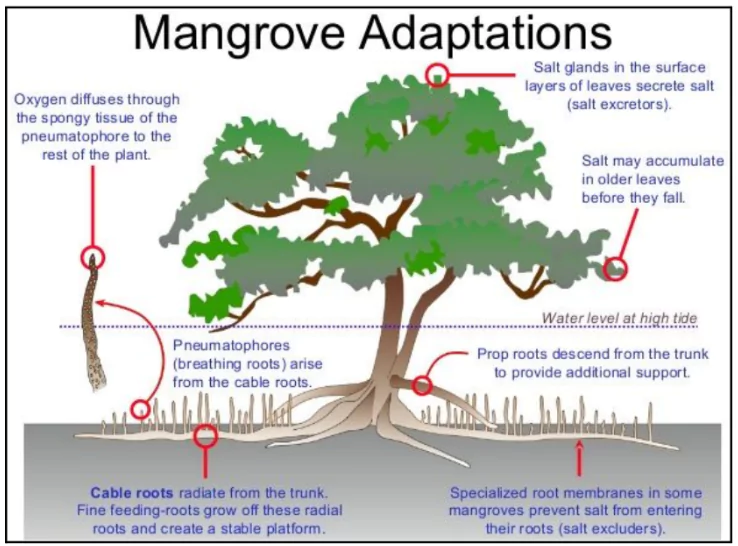According to a report by the Centre for Climate Change and Disaster Management, Anna University, mangrove forest cover in Tamil Nadu has almost doubled in the last few years, expanding from 4,500 ha in 2021 to 9,039 ha in 2024.
About Mangroves

- Location: Mangroves are found in tropical and subtropical areas, i.e., between 25°N and 25°S latitude.
- Mangroves have specialized adaptation to survive in the extreme conditions of the coastal environment.
- They have the ability to survive in waterlogged and anoxic soil, and to tolerate brackish water with the adaptations.
- Stilt Roots
- Pneumatophores
- Salt Excretory Glands
- Salt Excluding Roots
- Viviparous seeds
- There are 24-29 families and around 70 species in the world.
- Global Number: In 2020, an estimated 147,359 km2 of mangrove forest globally, 51% of which occurred in the AsiaPacific, with 29% in the Americas and 20% in Africa.
- Indonesia has the largest area of mangrove forest – totalling 20% of the global total – followed by Brazil, Australia, Mexico and Nigeria, which together contain almost half of the world’s mangroves.
India and Mangroves
- India is home to about 3 percent of the total mangrove cover in South Asia, with the Sundarbans in West Bengal and Bhitarkanika mangroves in Odisha being the richest in diversity.
- Sundarbans: It is one of the most biodiverse mangrove forests in the world.
- It is home to a wide variety of fauna, including the Bengal tiger, fishing cat, mangrove snakes, goliath heron, saltwater crocodile and water monitor lizard.
- Mangrove Cover in India: (ISFR 2023)
- Total Mangrove Cover: 4,992 sq km (0.15%) of the geographical area.
- Net Mangrove Cover decrease from 2021: 7.43 sq km
- Decrease: Highest losses in Gujarat (-36.39 sq km).
- Increase: Andhra Pradesh (+13.01 sq km) and Maharashtra (+12.39 sq km).
Significance of Mangroves
- Disaster Mitigation: Mangrove coverage acts as a natural barrier, reducing the impact of waves and protecting coastal areas from erosion.
- It stabilizes sedimentation and mitigates coastal flooding, thus providing a valuable defence against natural disasters.
- Ecosystem Services: Mangrove provide critical habitats of a diverse range of plant and animal species, and marine organisms, including commercially important fish species.
- Sundarbans host the world’s largest mangrove forest and are home to endangered species like the Bengal tiger and Ganges river dolphin.
- Natural Filter: Mangrove forests improve water quality and act as natural filters by trapping sediments, pollutants and excess nutrients.
- They play a role in the well-being of coastal communities and health of marine ecosystems.
- Carbon Sequestration: Mangrove ecosystems can absorb large amounts of carbon dioxide (CO2) from the atmosphere and store it in their biomass and sediments in a process known as sequestration.
- Globally, they are estimated to sequester 22.86 metric gigatonnes of CO2, which is about half the annual CO2 emissions from fossil fuels, land-use and industry.
- Livelihood: Mangroves contribute significantly to the livelihoods of 900,000 fisher households in India.
- They support artisanal fisheries and provide food and income for the local population.
- Tourism and recreation: Mangroves provide opportunities for eco-tourism, birding, kayaking, and other nature-based activities that can support local communities’ sustainable economic growth.
Challenges faced by Mangrove Ecosystem
- Stress on Mangrove: Mangroves are disappearing at a global loss rate of 1–2% per year, and the loss reached 35% during the last 20 years.
- Since 1996, the planet’s mangrove coverage has declined by 11,700-sq- km—an area thrice the size of Goa—with South and Southeast Asia witnessing the most significant loss.
- Declining Diversity: According to the IUCN red list, 11 of the 70 mangrove species in the world (16 percent) are at an elevated threat of extinction.
- Among them, two species, namely Sonneratia griffithii (critically endangered) and Heritiera fomes (endangered), are found in India.
- Rise in Sea Level: Sea levels rising at over 3 mm/year threaten mangrove ecosystems with sediment erosion and loss of salt marsh habitats.
- This leads to inundation stress, pushing mangroves landward and increasing salinity in those zones.
- Oil Pollution: Oil spill causes physical suffocation and toxicological impacts to mangroves.
- Spilled oil covers the aerial breathing mangrove roots inhabiting gaseous exchange and disrupting oxygen transport to underground roots leading to death of trees.
- Plastic Pollution: Mangrove ecosystems are at particular risk of being polluted by plastic carried from rivers to the sea.
- Southeast Asia is more affected by river-borne plastic pollution than any other region in the world.
- Lack of Protection: Mangroves outside reserve forests, sanctuaries and national parks in India are under threat as they do not have legal protections.
- Reducing Freshwater: Mangroves faces the consequences of reduction in freshwater flow due to the damming of rivers.
- These impacts are particularly high in the estuaries like the Cauvery where the rainfall is also less.
- Urbanization: Infrastructure and housing schemes for increasing the human population are destroying the mangroves, as mangroves are drained and land is cleared to make space for urban projects.
Way Forward
- Engaging Local Community in Conservation: Involving and enabling local communities is critical for long-term success.
- Policy Planning: Develop a comprehensive plan for the conservation and management of the mangrove forest, taking into account the local community’s needs and concerns.
- Pollution Abatement: Implement measures to reduce threats to the mangrove forest, such as controlling pollution, preventing illegal logging, and reducing coastal erosion.
- Afforestation: Encourage the planting of new mangrove trees to increase the forest’s size and improve its health.
- Strict Monitoring: Monitor the effectiveness of conservation efforts using data such as satellite imagery, water quality tests, and biodiversity surveys.
- Limiting Human Activities: Human activities such as urbanization should be limited around the mangrove forests.
- People who use mangroves for livelihoods should adopt sustainable approaches toward fisheries.
- Awareness: Refine knowledge of species benefiting and impacted by mangrove degradation and loss to understand the impact of mangrove change on local biodiversity and develop effective conservation and recovery plans.
Conclusion
Tamil Nadu’s mangrove cover has nearly doubled from 4,500 ha in 2021 to 9,039 ha in 2024, boosting carbon sequestration and ecosystem services. However, rising sea levels, pollution, and urbanization continue to threaten these vital coastal forests. Conservation efforts, community engagement, and strict monitoring are essential to sustain this growth and protect mangrove biodiversity.
![]() 17 Mar 2025
17 Mar 2025


